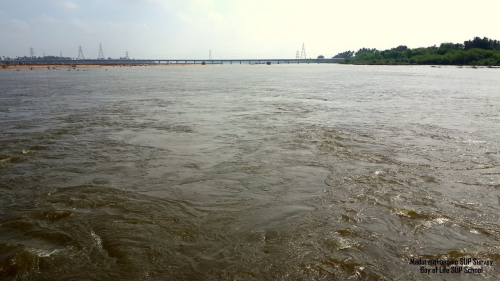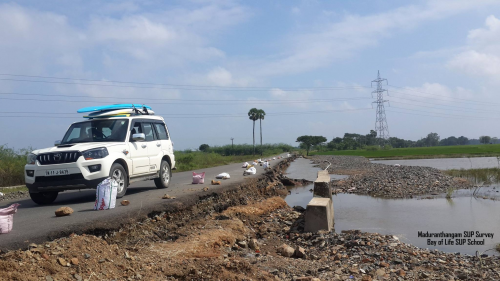Standup Paddle Boarding in Chennai’s Lost and Found Lakes
- Kumaran Geopaddler

- Dec 10, 2015
- 7 min read
Updated: May 25
As a child, whenever I crossed the outer limits of Chennai during my vacation to my hometown in the south of Tamil Nadu, I would be amazed by the chain of discontinuous hills and hillocks, vast lakes, and rivers that sometimes are completely dry. Later in my college days, I got to know that those rock masses are the Eastern ghats which were formed 2 billion years ago. The dry river that intrigued me is River Palar, which was once a perennial river in the geological past (which means long long ago). Eventually, my vacation trips dwindled, my interest in water bodies intensified, and I wished to explore the backyard of Chennai. Surprisingly for an extremely hot and humid place, it took me close to two decades to explore these waters.
In the early 2015, I began the survey of water bodies suitable for open and flat paddle boarding. After browsing the map of water bodies some countless times plus one, I started the groundwork to identify unpolluted waters and mark them as an ideal SUP destination.
The first step is obtaining permission to paddle from the concerned authorities, if required.
Next step is checking the surroundings - are the local people friendly to outsiders who enter the lake? Is the natural scenery good enough to give you a satisfactory experience, or are you going to feel like a swimming pool in a high-rise hotel?
Next is identifying natural and man-made threats such as currents, sediments, volume of the water, risk of barrier breach that can cause flooding, pollutants, dumping of wastes, etc and planning safeguards against them.
Next is logistics - do we have the necessary equipment, safety gear, and resources to paddle safely and back?
Paddling is done different times in different weather conditions to understand the waters and how one should plan, prepare, and navigate accordingly.
Once that is done, we need to do a detailed documentation that include HD photographs, video clips and track records to understand whether it is a viable paddling location.
After that though, ready, set, go!
It would be a genuine and pleasant surprise to discover how fast paddle boarding can go from a laid back activity to an active adventure sport within minutes. There is a vast number of unexplored water bodies in India which include numerous vast lakes, perennial rivers, estuaries and a coastline of more than 7500 kilometers. These also include an abundance of rare, diverse fauna and flora, with easy human accessibility to most of them. Also, these waters come a in wide variety of contrasting geographies within the country ranging from freezing glacial to warm tropical waters. With increasing exposure and economic upliftment comes an uptick of adventure sports lovers in India. Standup Paddleboarding enhances and compliments other interests like photography, wildlife tourism, and yoga. That's why I was keen on standup paddle boarding in Chennai’s lost and found lakes - its a gold mine on it's own!
In 2015 alone, I completed 12 Stand up paddle boarding survey missions along with our Bay of Life team and identified 10 new, pristine water bodies that are ideal for paddle boarding. Though there are famous water bodies like Dal Lake – Kashmir, rivers near Puri, Orissa, the unexplored lakes in the vicinity of Chennai city are my favorites. I felt a great satisfaction when I paddled in these lakes. On 10th of Dec 2015, just after a week after the historic deluge in Chennai, I set out with Selvam – Senior instructor and Ajith – Surf Instructor, from Bay of Life base, Kovalam, Chennai towards the nearby lake in my SUV with three standup paddle boards.
Keeping our final destination as Lake Maduranthangam, instead of taking an easy route through NH45 / GST Road, I took the road less travelled route through the villages of – Melavalampettai – Thirukalukundram in order to explore and witness the beauty of remote village landscapes. Due to the recent bountiful rain, we witnessed the landscape in which we traveled had blossomed into a lush and verdant plain. As we crossed the Palar River near Vallipuram, the excited crew discovered that Palar had reclaimed its natural course as it once existed as a great river before it became a shadow of its old self through a combination of events. Now fed by the unexpected torrential rains it flowed to its mighty capacity once again after long period of dryness. I felt incredibly lucky to witness this natural event again and wanted to spend some time in the bridge.

Selvam became excited as usual and wanted to jump right in. But we recognized the challenges posed by the gushing current of the River, and wisely decided not to test its strength. We got our first glimpse of the lake on NH 45 after crossing Maduranthagam town. The lake is believed to be built by the great Chola king Maduranthakar. The reservoir is used in irrigating more than a thousand villages in the region. In the distance we could see the overflowing water above the sluice gates. With the heavy rains filling the lake, people have been flocking to get a glimpse of this vast lake and it quickly turned into a picnic spot for locals.
We reached Mocherry colony which is situated to the south of this mighty lake. We paddled from Mocherry colony end towards the sluice gates which was located on the North side of the lake.

Much to our chagrin, we found out that we were paddling against strong winds of more than 15 knots, and waves of more than 0.75 meters. One can surf these waves during difficult conditions. At first, we paddled on our knees and covered over 3 kms. When we reached the center of the lake where the depth is more than 20 feet, we finally encountered a calm surface. Within a few minutes, we stood up and paddled and raced towards our target, the sluice gates. Approximately 300 to 400 meters before the sluice gates, we heard the thundering sound of overflowing water. The view from the paddle board was great and soon enough, we felt that we were being dragged by the current towards the overflowing Sluice gates. To avoid being further dragged in, we quickly turned around and paddled back to our starting point – Mocherry. Paddling downwind was an added advantage as we reached the shore in less than 45 minutes. The local kids were much excited to see the paddle boards. We took pictures with them and packed up for our next spot- Kolavai Lake.

After a sumptuous meal, we headed towards Chengalpattu town, a 30 minutes drive from Lake Maduranthangam towards Chennai. Lake Kolavai, is a perennial lake and is located in a rocky Terrain and spread across 802 hectares. It is fed by nearly 25 tanks located upstream in places such as Paranur, Hanumanthapuram and Kunnavakkam, and has a catchment area spread over 53 sq. km. Access to this perennial lake is quite tricky. With the help of GPS we reached the west shore of the Lake. After spending 15 minutes on shore survey, we found out that the shore is invaded with thousands of Prosopis plants and also filled with garbage, making it impossible to enter the water. In 2013, the Water Resources Department announced a project to rejuvenate this lake under the National Lake Conservation Plan. But there were no signs of resurrection for this dying lake. Once the local tourism department operated a Boat Club here which had also been closed. With a heavy heart, I decided to skip paddling here for now, and decided to do it in the future, with a belief that restoration of this once beautiful lake will happen soon.
It was early evening when we reached our base on State Highway 58. Around 8 kilometers before Thirukazhukundram, which is famous for its Vedagiriswarar Temple, also known as Kazhugu koil (Eagle temple), I spotted a 12 to 15 foot mud levee / embankment (an elevated ridge, running parallel alongside the banks of a river) on the right side. I immediately parked my car and requested Selvam to find out what was there on the other side of the levee. With the approaching Sunset I knew that it would become darker in less than 30 minutes. Selvam swiftly climbed up the narrow levee and within few seconds was out of sight. Soon after, we heard a long whistle in the direction Selvam went. We exited the car and hurried toward the sound of the whistle, reaching the top of the lLevee in under a minute. What I witnessed rendered me speechless. In the midst of nowhere lay a pristine lake, encircled by the breathtaking, ancient 2-billion-year-old Eastern Ghats.


Like the three friends who discovered the hidden pool in a Ruskin Bond novel, we three friends had discovered an unnamed lake. Overjoyed with our lucky discovery, we took our paddle boards and began walking towards the lake. Within 20 mins of paddling around, we were treated to one of the most beautiful Sunsets I had ever witnessed in all my years of my paddling experience. We did a second session on this lake, in order to explore the lake completely. By the end of a well spent day, I was feeling ecstatic and the sense of accomplishment began settling in. This lake had no name in the map, so we decided to christen it as “LAT 12 40”, going by its geographical coordinates.
Planning to paddle somewhere but getting the opportunity to paddle somewhere even better and unexpected would soon become a recurring theme in my life, as I would later witness in my Himalayan expedition and many more.



























Comments